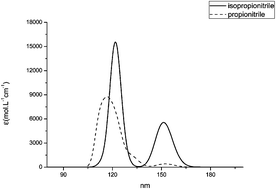Infrared study of matrix-isolated ethyl cyanide: simulation of the photochemistry in the atmosphere of Titan
Abstract
Low-temperature Ar matrix isolation has been carried out to investigate the infrared spectrum of ethyl cyanide (CH3CH2CN), a molecule present in the atmosphere of Titan. The λ > 120 nm and λ > 230 nm photolysis reactions of ethyl cyanide in an Ar matrix were also performed in order to compare the behaviour of this compound when it is submitted to high and low energetic radiations. These different wavelengths have been used with the aim to reproduce the radiation reaching the various parts of the atmosphere. Several photoproducts have been identified during photolysis such as vinyl cyanide (CH2![[double bond, length as m-dash]](https://www.rsc.org/images/entities/char_e001.gif) CHCN), cyanoacetylene (HC3N), and ethylene/hydrogen cyanide (C2H4/HCN), ethylene/hydrogen isocyanide (C2H4/HNC), acetylene/hydrogen cyanide (C2H2/HCN), acetylene/hydrogen isocyanide (C2H2/HNC), and acetylene:methylenimine (C2H2:HNCH2) complexes. Ethyl isocyanide (CH3CH2NC) and a ketenimine form (CH3CH
CHCN), cyanoacetylene (HC3N), and ethylene/hydrogen cyanide (C2H4/HCN), ethylene/hydrogen isocyanide (C2H4/HNC), acetylene/hydrogen cyanide (C2H2/HCN), acetylene/hydrogen isocyanide (C2H2/HNC), and acetylene:methylenimine (C2H2:HNCH2) complexes. Ethyl isocyanide (CH3CH2NC) and a ketenimine form (CH3CH![[double bond, length as m-dash]](https://www.rsc.org/images/entities/char_e001.gif) C
C![[double bond, length as m-dash]](https://www.rsc.org/images/entities/char_e001.gif) NH) have been identified as well. Photoproduct identification and spectral assignments were done using previous studies and density functional theory (DFT) calculations with the B3LYP/cc-pVTZ basis set.
NH) have been identified as well. Photoproduct identification and spectral assignments were done using previous studies and density functional theory (DFT) calculations with the B3LYP/cc-pVTZ basis set.


 Please wait while we load your content...
Please wait while we load your content...